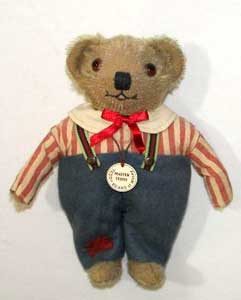
Chiltern Toy Works: A Stitch Above
Beginnings
Chiltern Toys started out as just that – a toy export company originally founded in Germany in 1881 by brothers Josef and Gabrielle Eisenmann. Josef was based in London while Gabrielle stayed in Bavaria. Around 1900 they were joined by Leon Rees who settled in London and married Josef’s daughter. It is thought that the Eisenmanns introduced teddy bears to England; certainly their company Eisenmann & Co. Ltd. was a good example of the close relationship Germany and England had before World War I when it came to toys and especially teddy bears.
Chiltern Toy Works came to life in 1908 in Chesham in Buckinghamshire, England, named after the Chilton Hills there. Chiltern started out as a toy factory, and didn’t graduate into making teddy bears until 1915 and the onset of World War I. Teddy bears were so popular that with the ban of imports from Germany during World War I, British toy companies felt they had to fill in the gap and so started teddy bear production themselves. Chiltern and Chad Valley were two such companies. For unlike many a craze that soon died out, teddy bears remained popular and the demand for them grew.
The first teddy bear born at Chiltern was “Master Teddy.” He was an unusual bear, with a large head, small ears and wide-set googly eyes. He had a wide stitched smile with a pink tongue showing through. He was dressed in a cotton shirt and blue felt trousers. His body was made of cotton, with only his head, feet and paws made out of mohair. Master Teddy was based on a character from a cartoon titled The Teddy Tail League published in the Daily Mail. He came in five sizes.
H. G. Stone Co.
Unfortunately, Josef died in 1919 before fully realizing his dreams; he left the factory to his son-in-law Leon Rees. The following year Rees entered into a partnership with Harry Stone and they formed the H. G. Stone Co. Stone definitely knew his teddy bears because he had been a director at J.K. Farnell. The company grew rapidly, opening a second factory in Tottenham, north London in 1921. One of the first teddy bears born in the new company was Baby Bruin, a small bear cub with wide open arms that just begged to be hugged and loved.
Rees and Stone formally registered the trademark “Chiltern Toys” in 1924 following the introduction of the “Hugmee Bear” in 1923. Chiltern Toys went on to become one of the top toy and teddy bear manufacturers in England.
Hugmee Bears
The Hugmee Bear was to become Chiltern’s premier teddy bear offering into the 1950’s. The bears had rather square faces with a long shaved muzzle and a broad smile that resembled Merrythought’s with vertical stitching for the nose with upturned stitches at each end above the mouth. The bears had the typical British large thighs, small ankles and large feet; long curved arms ending in spoon-like paws completed the picture; both feet and paws had stitched claws. They were made from mohair and were fully jointed. The head was stuffed with woodwool while the body was stuffed with kapok. Some of the bears had squeakers, which was surrounded by woodwool to protect it.
Although mohair teddies were the standard and the most popular, teddies made out of other fabrics could also prove to be commercially viable. Chilton produced one such teddy in 1929, introducing Silky Teddy, one of the first silk-plush teddies on the market.
World War II put a crimp in Chiltern’s teddy bear and soft toy manufacturing, but unlike many other British manufactures, they were able to keep their London factory going while they closed their Chesham site. Bears of the World War II era, including Hugmees, had smaller muzzles and bodies due to the shortage of materials; stitched claws also became a casualty of the war, as did large stitched noses. The end effect was a slightly glum look instead of the bear’s usual smiling face. However, instead of being less popular, these flat-faced Hugmees were extremely popular in the 1940’s and ‘50’s.
Growth After the War
Realizing that their current facilities wouldn’t be able to keep up with the demand for teddies once the war was over, Chiltern opened a much larger and more modern factory in Pontypool, Wales in 1946; they moved their entire production line to Wales the next year.
There, Chiltern continued to be an innovator, and in the 1950’s and ‘60’s was fortunate enough to have Pamela Howells as their chief designer. Her first design was “Teddy on a Bike” where the teddy bear was seated on a bicycle and arranged such that his legs would go up and down as if he was pedaling the bike. Howells also designed the “Ting-a-ling Bruin” which would emit a jingling sound when shaken. Chiltern also introduced plastic noses for their teddies in about 1958 to confirm with safety laws.
Changes and Chad Valley
Then Rees died in 1963 and everything changed. H. G. Stone Co. (Chiltern) was taken over by the Dunbee-Combex group, a company who made vinyl and rubber toys.
Four years later, in 1967, Chiltern was bought by Chad Valley. At first teddies made during this period had a joint Chad Valley Chiltern label before Chilterns was in the end ended.
Ended, but not forgotten, as Chiltern teddy bears remain favorites of collectors.
